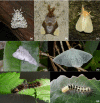Polyphagy and diversification in tussock moths: Support for the oscillation hypothesis from extreme generalists
- PMID: 29043049
- PMCID: PMC5632610
- DOI: 10.1002/ece3.3350
Polyphagy and diversification in tussock moths: Support for the oscillation hypothesis from extreme generalists
Abstract
Theory on plasticity driving speciation, as applied to insect-plant interactions (the oscillation hypothesis), predicts more species in clades with higher diversity of host use, all else being equal. Previous support comes mainly from specialized herbivores such as butterflies, and plasticity theory suggests that there may be an upper host range limit where host diversity no longer promotes diversification. The tussock moths (Erebidae: Lymantriinae) are known for extreme levels of polyphagy. We demonstrate that this system is also very different from butterflies in terms of phylogenetic signal for polyphagy and for use of specific host orders. Yet we found support for the generality of the oscillation hypothesis, in that clades with higher diversity of host use were found to contain more species. These clades also consistently contained the most polyphagous single species. Comparing host use in Lymantriinae with related taxa shows that the taxon indeed stands out in terms of the frequency of polyphagous species. Comparative evidence suggests that this is most probably due to its nonfeeding adults, with polyphagy being part of a resulting life history syndrome. Our results indicate that even high levels of plasticity can drive diversification, at least when the levels oscillate over time.
Keywords: Lymantriinae; Nymphalidae; host plant range; plasticity; speciation.
Figures



Similar articles
-
Host plant utilization, host range oscillations and diversification in nymphalid butterflies: a phylogenetic investigation.Evolution. 2014 Jan;68(1):105-24. doi: 10.1111/evo.12227. Epub 2013 Aug 29. Evolution. 2014. PMID: 24372598 Free PMC article.
-
Specialization and generalization in the diversification of phytophagous insects: tests of the musical chairs and oscillation hypotheses.Proc Biol Sci. 2014 Nov 22;281(1795):20132960. doi: 10.1098/rspb.2013.2960. Proc Biol Sci. 2014. PMID: 25274368 Free PMC article.
-
Do plant-eating insect lineages pass through phases of host-use generalism during speciation and host switching? Phylogenetic evidence.Evolution. 2017 Aug;71(8):2100-2109. doi: 10.1111/evo.13292. Epub 2017 Jul 11. Evolution. 2017. PMID: 28654210
-
Niche explosion.Genetica. 2011 May;139(5):551-64. doi: 10.1007/s10709-010-9513-5. Epub 2010 Nov 23. Genetica. 2011. PMID: 21104426 Review.
-
Understanding processes at the origin of species flocks with a focus on the marine Antarctic fauna.Biol Rev Camb Philos Soc. 2018 Feb;93(1):481-504. doi: 10.1111/brv.12354. Epub 2017 Aug 10. Biol Rev Camb Philos Soc. 2018. PMID: 28799256 Review.
Cited by
-
Range size positively correlates with temperature and precipitation niche breadths but not with dietary niche breadth in triatomine insects, vectors of Chagas disease.PLoS Negl Trop Dis. 2024 Aug 16;18(8):e0012430. doi: 10.1371/journal.pntd.0012430. eCollection 2024 Aug. PLoS Negl Trop Dis. 2024. PMID: 39150980 Free PMC article.
-
Bird lineages colonizing urban habitats have diversified at high rates across deep time.Glob Ecol Biogeogr. 2022 Sep;31(9):1784-1793. doi: 10.1111/geb.13558. Epub 2022 Jun 19. Glob Ecol Biogeogr. 2022. PMID: 36246452 Free PMC article.
-
Species-complex diversification and host-plant associations in Bemisia tabaci: A plant-defence, detoxification perspective revealed by RNA-Seq analyses.Mol Ecol. 2018 Nov;27(21):4241-4256. doi: 10.1111/mec.14865. Epub 2018 Oct 10. Mol Ecol. 2018. PMID: 30222226 Free PMC article.
-
Variably hungry caterpillars: predictive models and foliar chemistry suggest how to eat a rainforest.Proc Biol Sci. 2017 Nov 15;284(1866):20171803. doi: 10.1098/rspb.2017.1803. Proc Biol Sci. 2017. PMID: 29118136 Free PMC article.
-
Evolved Transcriptional Responses and Their Trade-Offs after Long-Term Adaptation of Bemisia tabaci to a Marginally Suitable Host.Genome Biol Evol. 2022 Aug 3;14(8):evac118. doi: 10.1093/gbe/evac118. Genome Biol Evol. 2022. PMID: 35880721 Free PMC article.
References
-
- Agapow, P. M. , & Isaac, N. J. B. (2002). MacroCAIC: Revealing correlates of species richness by comparative analysis. Diversity and Distributions, 8, 41–43.
-
- Agosta, S. J. , Janz, N. , & Brooks, D. R. (2010). How specialists can be generalists: Resolving the “parasite paradox” and implications for emerging infectious disease. Zoologia, 27, 151–162.
-
- Beccaloni, G. W. , Scoble, M. , Kitching, I. J. , & Simonsen, T. J. (2005). The global Lepidoptera Names Index (Website by Mike Sadka).
-
- Celorio‐Mancera, M. D. , Wheat, C. W. , Huss, M. , Vezzi, F. , Neethiraj, R. , Reimegard, J. , … Janz, N. (2016). Evolutionary history of host use, rather than plant phylogeny, determines gene expression in a generalist butterfly. BMC Evolutionary Biology, DOI: 10.1186/s12862‐016‐0627‐y. - DOI - PMC - PubMed
LinkOut - more resources
Full Text Sources
Other Literature Sources

